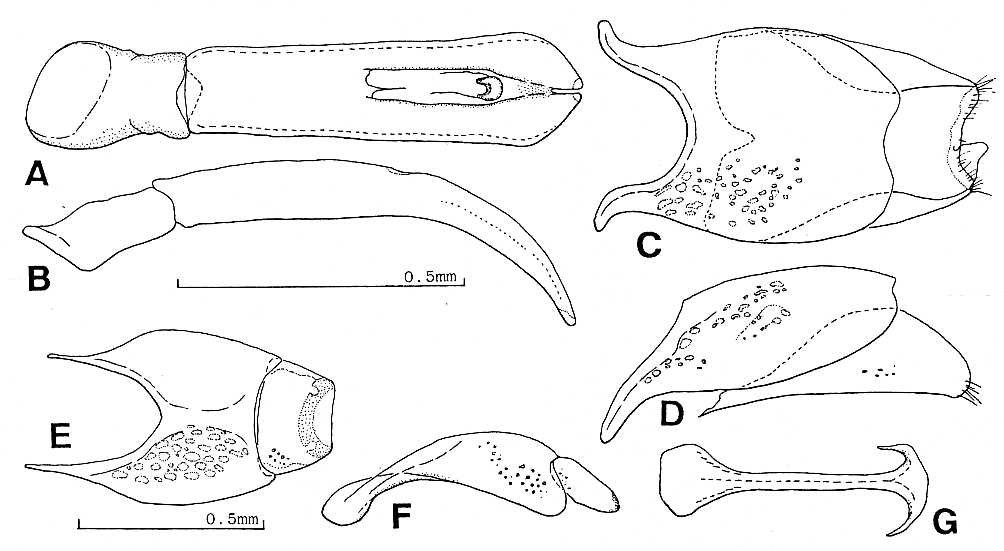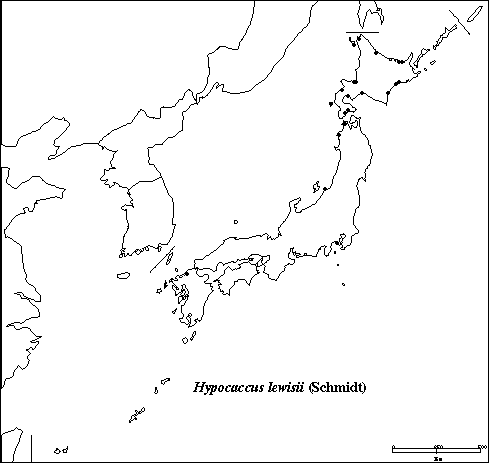
Saprinus lewisii Schmidt, 1890: 53 [Japan: Hakodate].
Hypocaccus lewisii: Reichardt, 1926: 273; Reichardt, 1941: 308, 320, fig. 167.
Hypocaccus (Hypocaccus) lewisii: Kryzhanovskij and Reichardt, 1976: 226.
Japanese name: Karakane-hamabe-emma-mushi.
Hypocaccus lewisi (sic): Mazur, 1970, 58 [Korea].
Hypocaccus (Hypocaccus) lewisi (sic): ESK & KSAE, 1994, 136 [Korea].
Hypocaccus (Hypocaccus) lewisii: Ohara, 1994, 248; 1997, 173 [Kuril Isls.].
Description (Ohara. 1994).
Body length, PPL, 2.26 - 3.17 mm (2.81 ± 0.05, n=20), PEL, 2.13 - 2.94 mm (2.55 ± 0.04, n=20). Width, 1.67 - 2.39 mm (2.07 ± 0.04, n=20). Body oval and moderately convex. Biometric data are given in Table 49. Cuticles shining and black or nearly so with a strong bronzy, blue or brassy lustre; antennae dark rufopiceous with club rufotestaceous; legs dark reddish brown.
Frontal stria of head (Fig. 142D) complete, well impressed and straight on each side. Supraorbital stria well impressed. Disk of front with a transverse ruga, and usually densely and strongly rugose in central area, and impunctate posteriorly. Epistoma scabrose.
Pronotal side (Fig. 140D) feebly arcuate and not strongly convergent on basal five-sixths, thence strongly arcuate and convergent to apices. Marginal stria complete and subcarininate. Disk coarsely and densely punctate, the punctures becoming more rugose laterally, and impunctate mediobasally except on mid line. Basal margin of pronotum with two or three rows of coarse punctures, and with fine ones intermingled, the coarse punctures becoming larger in antescutellar area and lateralmedian fifth of pronotum, and finer laterally.
Epipleura of elytra smooth and even. Marginal epipleural stria complete, finely impressed. Marginal elytral stria well impressed, carinate, and complete, its apical end continuing across elytral apex and united with the apical end of sutural stria at medio-apical angle of elytron. External subhumeral stria absent. Internal subhumeral stria shortly present on medial third. Oblique humeral stria well impressed on basal third. First dorsal stria unclearly present on basal half, usually consisting of coarse punctures in a row, close to and parallel with the oblique humeral stria. Second, 3rd and 4th dorsal striae indistinguishable from elytral punctures, sometimes 2nd represented by a ruga on basal half. Sutural stria deeply impressed and complete, the apical end united with marginal elytral stria. Surface of elytra densely covered with coarse and somewhat longitudinal punctures except on mediobasal area, basal sixth of interstice between 2nd and 3rd dorsal striae and flanks of elytra; elsewhere sparsely covered with microscopic punctures.
Propygidium densely and moderately punctate, the punctures becoming finer and sparser basally. Pygidium densely and moderately punctate, the punctures finer near apex.
Anterior margin of median portion of prosternum (Fig. 141D) weakly obtuse-angulate. Preapical foveae distinctly present. Keel somewhat broad, moderately compressed, its anterior apex acute, rarely truncate. Descending lateral striae strongly carinate and convergent apically. Carinal striae present on basal two-thirds, parallel to each other on median third, and divergent basally, rarely its apical ends divergent, attaining to the descending lateral stria. Lateral sides of keel sparsely with moderate punctures.
Anterior margin of mesosternum feebly emarginate, its marginal stria carinate and complete. Disk smooth, sparsely with microscopic punctures. Meso-metasternal suture lightly impressed, accompanied by a parallel coarsely crenated line. Intercoxal disk of metasternum smooth except in a transverse apical band, which is sparsely and finely punctate. Lateral metasternal stria well impressed, extending obliquely and posteriorly, and reaching near hind coxae. Lateral disk evenly covered with coarse and setiferous punctures, impunctate along the lateral metasternal stria. Metepisternum densely and coarsely punctate.
Intercoxal disk of 1st abdominal sternum completely striate on each side, and sparsely covered with fine punctures along anterior margin.
Protibia with 10 spinules on outer margin, its apical-outer angles bearing three large spinules.
Male genitalia as shown in Fig. 144.
Table 49. Biometeric data of Hypocaccus lewisii (Schimdt)
----------------------------------------------------------------------
APW 0.75-1.01 (0.89±0.01) 20
PPW 1.57-2.13 (1.88±0.03) 20
PL 0.75-1.08 (0.93±0.02) 20
EL 1.24-1.80 (1.56±0.03) 20
EW 1.67-2.39 (2.07±0.04) 20
ProW 0.98-1.37 (1.22±0.02) 20
ProL 0.23-0.43 (0.32±0.01) 20
PyL 0.86-1.43 (1.24±0.03) 20
PTL 0.62-0.98 (0.74±0.02) 20
MSTL 0.65-0.88 (0.74±0.02) 20
MTTL 0.72-0.95 (0.88±0.02) 20
-----------------------------------------------------------------------
Remarks. Hypocaccus lewisii resembles H. axeli, but differs by the rather dense punctation on the pronotum and the punctation on the pygidium without an impunctated area.
Hypocaccus lewisii occurs mainly in a sandy beach. It is occasionally found also on the sandy beach of mountaion rivers (Kurosawa, 1988).

[Hokkaidô] 1 ex., Hakodate, 17/vii/1954, T. Nakane leg. (NA); 1 ex., Ditto, 15/vii/1952, K. Honma leg. (EIHU); 1 ex., Nanae-hama, Hakodate, 17/viii/1977, Y. Kusui leg.; 1 ex., Ditto, 5/iv/1978, N. Nishikawa leg.; 1 ex., Nezaki-chô, Hakodate-shi, 15/v/1978, H. Sawada leg.; 1 ex., Ditto, 19/vii/1952, K. Honma leg. (EIHU); 2 exs., Yokoma, Suttu, 11/vii/1979, T. Fujisawa leg. (EIHU); 2 exs., Kojô-hama, Shiraoi, 30/vii/1953, M. Ôtake leg.; 2 ex., Zenibako, Otaru, 30/v/1977, 23/vi/1977, N. Nishikawa leg.; 1 ex., Ishikari, 24/vi/1987, A. Iwasaki leg.; 1 ex., Obira, Rumoi, 28/vii/1985, M. Ôhara leg.; 1 ex., Shari-chô, 14/x/1987, H. Torikura leg.; 7 exs., Shiranuka, 25/vi/1985, M. Ôhara leg.; 1 ex., Abashiri, 1/viii/1954, T. Nakane leg. (NA). <Okushiri Is.> 3 exs., Aonoe, 28/vi/1986, Y. Kusui leg.
[Honshû] <Aomori-ken> 1 ex., Nakanosawa, Mutsu, 8/vi/1989, H. Saito leg. <Fukushima-ken> 2 exs., Fujimi-kaigan, Iwaki, 25/vi/1988, K. Tazoe leg. <Fukui-ken> 2 exs., Fujima-kaigan, Iwaki, 25/vi/1988, K. Tazoe leg.
[Kyûshû] <Fukuoka-ken> 1 ex., Ainoshima, 22/v/1983, S. Nakao leg.
[?] 1 ex., Imahama, 23/v/1948, no collector's name.
Specimens examined [additional records]. (Ohara, 1999a).
[Hokkaido] Rishiri Is.: Numaura (6 exs., 29/vii/1994), M. Ohara. Proper: Sakanoshita, Wakkanai (1 ex., 10/viii/1974), Y. Kusui; Okoppe-gawa-kako, Okoppe-chô (5 exs., 21/vi/1994, HOR), S. Hori; Tomakomai-kaigan, Tomakomai (1 ex., 9/vi/1974), H. Onodera; Shioya, Otaru (5 exs., 14/v/1994, SA), K. Sasaki; Kotan, Atsuta (1 ex., 22/v/1994; 2 exs., 18/vi/1995, SA), K. Sasaki; Nanae-hama, Kamiiso (1 ex., 15/viii/1997, SA), K. Sasaki; Rebunnge, Toyoura (1 ex., 22/v/1994, SA), K. Sasaki.
[Honshu] Aomori-ken: Moriyama, Iwasaki-mura (1 ex., 26/vii/1991, APM), S. Yamauchi; Kodomari-mura (1 ex., 15/vi/1983, APM), K. Shimoyama. Kanagawa-ken: Shichiri-ga-hama, Kamakura (1 ex., 10/x/1989), K. Kawada.
Ohara (1997) : Record from Kuril Islands.
A team of American, Russian and Japanese biologists surveyed the flora and fauna of the middle Kuril Islands, Russia in August, 1995. As a team member, I collected coleopterans from Urup, Broutona, Chirpoi, Simushir, Ushishir, Ketoi, and Rasshua islands. Hypocaccus lewisii, from Urup, was the only histerid collected in this expedition. This species was previously known from Kyûshû, Honshû, Hokkaidô, southern Primorsky and southern Sakhalin. This is a new record for the Kuril Islands.
Histeridae collected in middle Kurils.
Hypocaccus (Hypocaccus) lewisii (Schmidt)
Saprinus lewisii Schmidt, 1890: 53.
Hypocaccus (Hypocaccus) lewisii: Ôhara, 1994: 248.
Specimens examined. Kuril Islands. Urup Island. [UR-95-MO-003]
1 ex., 45°51.04'N-149°46.12'E, Otkrytyy bay (Tokotan-wan
in Japanese), under peddles and rocks along stream, 4-VIII-1995,
hand picking, M. Ôhara leg.; [UR-95-MO-001] 2 exs., 45°51.49'N-149°46.95'E,
Otkrytyy bay, under logs and rocks on the beach, 4-VIII-1995,
hand picking, M. Ôhara leg.; [UR-95-MO-004] 2 exs., 45°51.59'N-149°47.05'E,
Coastal hills in Otkrytyy bay, on sand of the hills, 5-VIII-1995,
hand picking, M. Ôhara leg.; [UR-95-PO-017] 8 exs., 45°51.49N-149°42.67E,
Inland coastal margin of Otkrytyy bay, shore of Tokotan lake,
picked from sandy shore, alt. 5 m., 5-VIII-1995, by hand and forceps,
N. Minakawa leg.; [UR-95-MO-008] 1 ex., 46°12.84'N-150°18.69'E,
Novo-Kurylisk bay (Kinko-wan), near mouth of the Bystraya river,
on sand of the shore, 8-VIII-1995, hand picking, M. Ôhara
leg.
Distribution. Japan (Hokkaidô, Honshû, Kyûshû),
Russian Far East (Kuril Islands: Urup Is., Primorsky, Sakhalin).
New to Kuril Islands.
